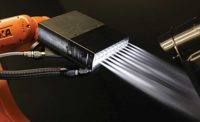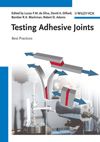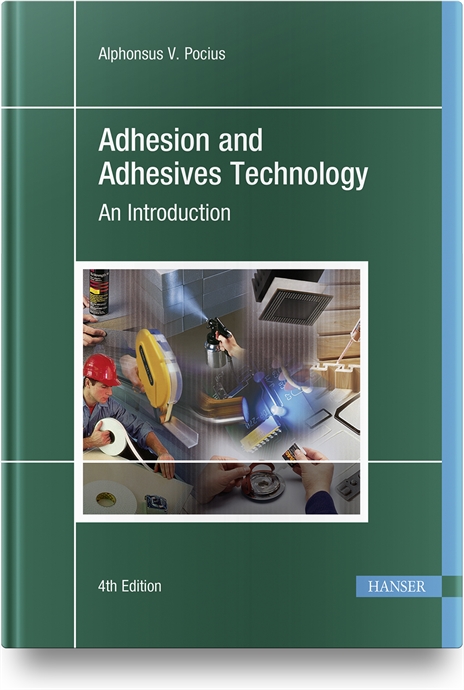A wide variety of adhesives are used to manufacture complicated electrical and electromechanical devices. These adhesives are normally customized for the specific materials to be joined and are chosen to hold parts together indefinitely. Usually, no thought is given to disassembly. However, disassembly is becoming an increasingly important aspect of manufacturing. For environmental and economic reasons, more manufacturers are concerned with "cradle to grave" management of their products. In addition, manufacturers are designing future electronic systems to be more assessable than in the past, so that expensive components can be repaired or upgraded.
One way to facilitate disassembly is with removable adhesive bonds. Easy disassembly of critical bonds allows products to be upgraded as new technology becomes available or rebuilt if defects are discovered during manufacturing or after deployment. Recycling is easier if bonds can be broken without damage to the components.
Adhesive bonds are normally taken apart by heating an adhesive above its softening point and prying the materials apart. This works well for small and robust parts. But what about large surface area bonds or bonds between delicate parts? We occasionally bond electronic assemblies that are encapsulated in foam. The foam is low-density and therefore low-modulus. Wouldn’t it be great if the bond would come apart at the snap of one’s fingers or the flip of a switch? We can actually do that now (by flipping a switch not snapping fingers) with a thin heating circuit and a thermo-reversible adhesive.
A New Approach
Our approach to a thermally removable adhesive bond is new. It relies on an adhesive that contains a thermally reversible chemistry, namely Diels-Alder. Adducts form between a furan and a maleimide below approximately 60 C. The adducts open above approximately 90 C, which results in low molecular weight and low modulus constituents. The modulus can be many orders of magnitude lower than a conventional adhesive heated above its glass transition temperature.Below 60 C, the cross-linked, diamine-cured epoxy behaves like other elastomeric epoxy adhesives, with similar bond strengths and other properties. However, above approximately 90 C, the adducts open. The adhesive is no longer cross-linked, and the molecular weights are low. Most importantly, the modulus is very low (even liquid at a high enough temperature), and the adhesive bond can be broken with a low force. Often, metallic parts separate with only the force of gravity. The low bond breaking force results in minimal collateral damage to the electrical and electromechanical components during disassembly.
When the adhesive cools to below 60 C, the bond will reform. However, this rebonding capability is finite. The adhesive will be able to bond and rebond several times, but eventually it will become nonremovable.
We use the adhesive in many different applications.
For one application, we need to bond two metallic surfaces and remove them if required. The metals are different and have different coefficients of thermal expansion. We formulated a removable elastomeric adhesive specifically for this application. The adhesive strength was tested with standard lap-shear testing and found to be comparable to commercial elastomeric adhesives.
The adhesive is prepared in sheets that are 10 mils thick. The adhesive sheet is cut to size, applied to one of the surfaces to be bonded, and melted. The bond is formed by bringing the melted adhesive into contact with the other metal surface and curing the assembly at 60 C. The adhesive in this example has a removal temperature of 100 C. The temperature at which the adhesive liquefies can be varied between 100 C and 160 C by adjusting the formulation and mixture of the bismaleimides. To break the bond, the components are heated to 100 C, and the parts fall away from each other with only the force of gravity. At the removal temperature, the epoxy adhesive breaks apart into small molecules with a low modulus.
For another adhesive problem, we need to bond two components encapsulated in foam. The foam protects temperature-sensitive electronic components and therefore cannot be heated even to the removal temperature of the adhesive, 100 C. To accomplish this, we use a thin heating circuit (7 mils thick) that we embed within the adhesive layer. Each side of the heating element is coated with adhesive. The element is then sandwiched between the two foam components, and the adhesive is cured at 60 C. The bond is broken by plugging in the heating circuit and heating the adhesive to over 100 C. At that temperature, the bond can be easily pried apart. This is done with little heat being conducted into the foam or the temperature-sensitive components within it. The disassembled foams are intact.
Easily removable adhesive joints allow for versatile component assembly, easier and cheaper component repair, easy upgrading, and simplified dismantlement and recycling. By incorporating thermally reversible Diels-Alder chemistry into epoxy resins, we have formulated a range of removable elastomeric adhesives. These adhesives may be advantageous for bonding expensive electrical or electromechanical components.






